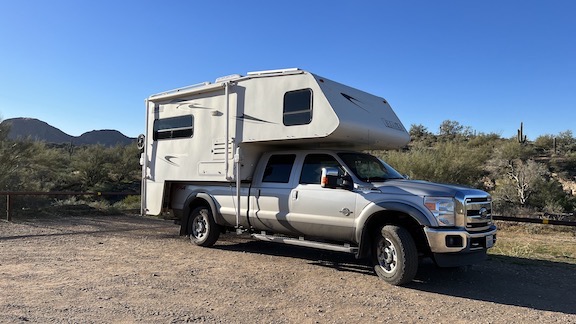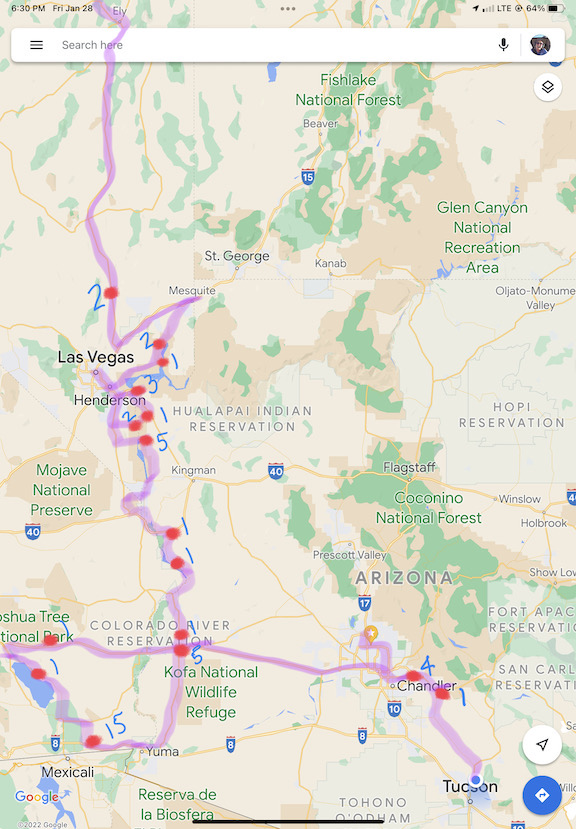I discover that a “do it all” biodegradable soap is not the answer to my on-the-water cleaning needs.
One of the things that bothers me about living on a boat is gray water — the water that drains away from sinks and showers. In the RV world, gray water is collected in its own separate waste tank. Although it can be dumped separately from black water (toilet waste), both tanks are often dumped together in a facility designed to receive it. But on a boat, gray water is drained directly into the body of water the boat is floating on. (Don’t worry; black water on a boat is contained in a tank and cannot be dumped anywhere on inland waterways or near shore.)
I remember the first time I realized this. It was in the 1980s and I was on a houseboating trip with some friends. One of us was washing dishes and I happened to look overboard and see soap suds on the surface of what I’d always thought was pristine Lake Powell. I was kind of horrified.
Lots of folks will argue that it’s “just a little soap” in a big body of water. And they would be right. But I tend to think on the macro level at times and thought: what if everyone just dumped their gray water into the nearest river, stream, or lake? Wouldn’t that hurt the fish and water birds?
So, like the environmentally conscious person I try to be, I thought I’d find a more environmentally friendly soap to use aboard my new boat, which I expect to be living on for months at a time.
Choosing Dr Bronners

Here’s what the Tea Tree scented Dr. Bronners bottle looks like.
Dr Bronner’s All-One Soap came to mind first. If you’ve ever been in a health food store or walked through the natural foods section of your supermarket, I’m sure you’ve seen it. It comes in plastic bottles absolutely covered in crazy fine print text. It’s supposed to be pure-castle soap and its website says its good for “Face, body, hair—food, dishes laundry, mopping, pets—the best for human, home, and Earth!” (I think someone in their marketing department needs a lesson in punctuation, although I am a fan of the Oxford comma.)
I think Peppermint may have been the original scent because that’s what I first used on camping trips years ago. It made my skin tingle. Later, I bought the Eucalyptus scent, which I preferred, for my campers. I used it in the bathroom for washing up, including showering. When I had really short hair, I used it for shampoo.
I figured that it would be convenient to have one soap I could use for everything, so I bought a large bottle and a small one — one for the galley and one for the head. I chose the Tea Tree scent because I wanted to associate a new smell with my new boat — I didn’t want it to smell like my RVs. And when I went out on my recent 10-day cruise around Puget Sound, that’s the only soap I brought along.
The Experiment
During the ten days I was away, I used Dr Bronners for washing anything that needed washing: my face, hands, body, and hair; dishes, pots, and pans; and laundry. And it didn’t take long to realize that Dr Bronners simply wasn’t doing it all, as its marketing materials claimed. Specifically:
- As a body soap, it’s an astringent that sucks the oils out of your skin. While I like that in summer time when I’m sweaty and stinky, I don’t think it would be good in the winter. (I will likely continue to use it, however.
- As a shampoo, it stripped all of the natural oils out of my hair, leaving it in a severely tangled mess. If I didn’t have the foresight to bring along some leave-in conditioner, I would have had to have my hair shaved off to remove the knots. (Knowing in advance how it was on skin gave me insight about how it might be on hair.)
- As a dish soap, it could not sufficiently cut through grease, no matter how much I used or how hot the water was. No matter how many times I washed something greasy, there was always a thin, slick film left behind.
- As a laundry soap, I just don’t feel sure that it really cleaned my clothes. I didn’t see any suds in the water, but since none of my clothes were really grimy, I have no way to judge how well it worked.
Before the end of my trip, I went out and bought a small bottle of Dawn dish detergent. It was pointed out to me that environmentalists use Dawn to clean oil off wildlife after spills, so there must be something environmentally friendly about it. (Or maybe it’s just more environmentally friendly than crude oil?) I just couldn’t deal with that layer of grease on my “clean” pots and pans.
Conclusion
As far as I’m concerned, the experiment is over. I’ll use up the rest of the Dr Bronners I have on board for washing my hands and face and showering. I’ll use my regular shampoo on my hair — heck, I take most showers at marina facilities anyway. I’ll use the same laundry detergent pods I use at home for my laundry, which is always done in a laundromat. And I’ll use Dawn (sparingly) for washing my dishes.
In the meantime, if you have any suggestions for more environmentally friendly cleaning products that actually work, please let me know. I want to do the right thing, but I also want clean things to be clean.


